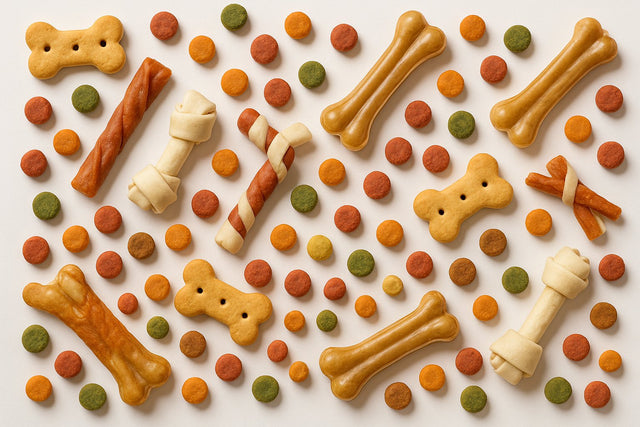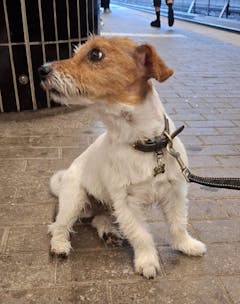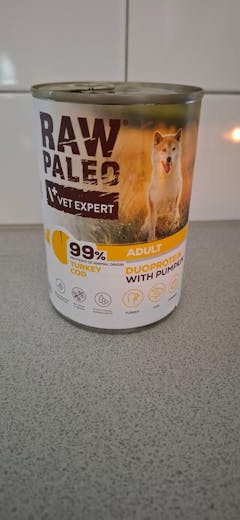
Hundgodis & Tuggbitar

Hundgodis & Tuggbitar: Den Perfekta Belöningen och Aktiveringen
För varje hundägare är hundgodis och tuggbitar en oumbärlig del av vardagen. De är inte bara en läcker munsbit som får svansen att vifta; de är också kraftfulla verktyg för träning, mental stimulans, tidsfördriv och inte minst för att bidra till god tandhälsa. På Zoostar.se har vi samlat ett omfattande sortiment av hundgodis och tuggbitar som passar alla hundar, oavsett ålder, storlek, ras eller specifika behov. Från små träningsgodbitar till långvariga tuggben som sysselsätter din hund i timmar, hjälper vi dig att hitta de produkter som bäst berikar din fyrbenta väns liv.
Varför är Hundgodis & Tuggbitar Så Viktiga?
Hundgodis och tuggbitar fyller många viktiga funktioner i en hunds liv:
- **Träning och Belöning:** Detta är kanske den mest uppenbara användningen. Godis är en effektiv form av positiv förstärkning som hjälper din hund att associera önskade beteenden med något positivt, vilket påskyndar inlärningen av allt från grundläggande kommandon till mer avancerade trick. Små, lättsmälta bitar är idealiska för detta.
- **Tandhälsa och Munhygien:** Många tuggbitar är speciellt utformade för att främja tandhälsa. Genom att tugga på rätt material kan hunden mekaniskt skrapa bort plack och tandsten, vilket bidrar till friskare tänder och tandkött samt minskar dålig andedräkt. Regelbunden tuggning stärker även käkmuskulaturen.
- **Mental Stimulans och Minska Tristess:** Långvariga tuggbitar ger hunden en meningsfull sysselsättning. Detta är särskilt viktigt för att förhindra tristess, destruktivt tuggande (på möbler eller skor!) och kan även verka lugnande för hundar med separationsångest eller de som känner sig stressade. Tuggning frigör endorfiner, vilket bidrar till hundens välbefinnande.
- **Berikning och Välbefinnande:** Att få en godbit är en glädjespridare! Det är ett enkelt sätt att visa din hund kärlek och uppskattning, samt att variera dess vardag. Vissa hundgodis är även berikade med extra näringsämnen som bidrar till t.ex. hud- och pälshälsa eller ledhälsa.
Olika Typer av Hundgodis & Tuggbitar
Utbudet av hundgodis och tuggbitar är enormt, och varje typ har sina egna fördelar:
1. Träningsgodis & Belöningsgodis:
- **Små och Lättsmälta:** Dessa är oftast små, mjuka och mycket smakrika, perfekta för snabba belöningar under träningspass. De ska inte distrahera hunden för länge.
- **Lågkalori:** För hundar som lätt går upp i vikt eller under intensiv träning där många godbitar ges, finns lågkalorialternativ.
- **Enkel att Bryta:** Många träningsgodbitar kan enkelt brytas i ännu mindre bitar för att förlänga träningspasset utan att ge för mycket kalorier.
2. Tuggben för Tandhälsa:
- **Mekanisk Rengöring:** Dessa tuggbitar är speciellt utformade med en struktur som hjälper till att skrapa bort plack och tandsten från tänderna när hunden tuggar.
- **Tandvårdande Ingredienser:** Vissa innehåller tillsatser som zink eller eukalyptusolja som motverkar bakterier och dålig andedräkt.
- **Olika Hårdhetsgrader:** Finns i olika hårdhetsgrader för att passa hundens tuggstyrka och tandhälsa.
3. Långvariga Tuggbitar & Naturliga Tugg:
- **Sysselsättning:** Perfekt för att hålla hunden sysselsatt under längre perioder, t.ex. när den är ensam hemma eller när du vill att den ska lugna ner sig. Exempel inkluderar torkade animaliska produkter som tjurmuskel, grisöron, eller kängurufötter.
- **Stressreducering:** Långvarig tuggning är en naturlig och lugnande aktivitet för hundar.
- **Naturliga Alternativ:** Många naturliga tuggbitar är tillverkade av endast en ingrediens och är fria från tillsatser, vilket är bra för hundar med känslig mage eller allergier.
4. Funktionella Godbitar:
- **Hälsofördelar:** Dessa godisbitar är berikade med specifika ämnen för att stödja olika hälsoområden, t.ex. glukosamin och kondroitin för leder, omega-fettsyror för hud och päls, eller probiotika för matsmältningen.
- **Komplement till Foder:** Kan vara ett utmärkt komplement till hundens vanliga hundmat (som torrfoder, våtfoder eller veterinärfoder till hund) om den har specifika behov.
5. Fyllda Tuggben och Aktiveringsleksaker:
- **Extra Utmaning:** Ben som kan fyllas med våtfoder, jordnötssmör eller specialgjorda pastor ger en extra utmaning och förlänger tuggtiden. Dessa kombinerar glädjen av tuggning med mental stimulans.
Att Välja Rätt Hundgodis & Tuggbitar för Din Hund
När du ska välja hundgodis och tuggbitar är det viktigt att tänka på:
- **Hundens Ålder och Storlek:**
- **Valpar:** Behöver mindre, mjukare och lättsmälta bitar. Valpgodis är ofta specifikt anpassat. Undvik hårda tuggben som kan skada deras känsliga tänder.
- **Vuxna Hundar:** Större utbud, men välj efter tuggstyrka.
- **Seniorhundar:** Mjukare alternativ om de har tandproblem eller känsligt tandkött. Lättsmält är ofta att föredra.
- **Allergier och Känslighet:** Läs ingredienslistan noggrant. Om din hund har allergi mot spannmål, välj spannmålsfritt godis. För känsliga magar finns godis med få ingredienser eller singelproteinkällor.
- **Kaloriinnehåll:** Kom ihåg att godis och tuggbitar innehåller kalorier. Dessa ska räknas in i hundens dagliga kaloriintag för att undvika övervikt. En generell regel är att godis inte ska utgöra mer än 10% av hundens dagliga kaloriintag. Om din hund är på viktminskningsdiet, välj lågkalorigodis eller använd delar av hundens vanliga foder som belöning.
- **Tuggvanor och Säkerhet:** Om din hund är en "slukare", välj större och hårdare tugg som inte kan sväljas hela. Var försiktig med extremt hårda ben som kan orsaka tandfrakturer eller flisor. Övervaka alltid din hund när den tuggar.
- **Kvalitet:** Välj produkter från pålitliga märken med hög kvalitet på råvarorna och tydliga ingredienslistor.
Zoostar.se – Ditt Förstaval för Hundgodis & Tuggbitar
På Zoostar.se brinner vi för att erbjuda produkter som bidrar till din hunds hälsa och lycka. Vårt sortiment av hundgodis och tuggbitar är noga utvalt för att möta alla behov – från de minsta valparna (som du även hittar mjölkersättning och valpvälling för) till de äldsta seniorerna (foder för äldre hundar kan kompletteras med mjukare godis).
Vi erbjuder ett brett utbud av smaker, texturer och funktioner för att du ska kunna hitta det perfekta godiset för din hund. Utforska vårt hela sortiment av hundmat och foder, inklusive torrfoder för hundar, våtfoder för hundar och veterinärfoder till hund. Ge din hund den glädje och stimulans den förtjänar med hundgodis och tuggbitar från Zoostar.se!
Vanliga frågor om Hundgodis & Tuggbitar
Här besvarar vi några av de mest frekventa frågorna vi får angående hundgodis och tuggbitar.
Varför är hundgodis och tuggbitar viktiga för min hund?
Hundgodis och tuggbitar är mer än bara en utsökt belöning; de spelar en viktig roll i hundens liv, från träning och tandhälsa till mental stimulans och välbefinnande. Att förstå varför dessa är viktiga hjälper dig att välja rätt produkter och använda dem på ett effektivt sätt. Här är de främsta anledningarna till varför hundgodis och tuggbitar är viktiga: 1. Belöning och Träning: - Positiv förstärkning: Godis är ett oumbärligt verktyg inom positiv förstärkning vid träning. När en hund utför en önskad handling och omedelbart belönas med något den älskar (godis), förstärks beteendet och hunden blir mer benägen att upprepa det. - Inlärning: Från grundläggande kommandon som "sitt" och "stanna" till mer avancerad lydnad och trickträning, är godis ett kraftfullt incitament som påskyndar inlärningsprocessen. - Relation: Att belöna din hund stärker bandet mellan er och bygger en positiv association med dig. 2. Tandhälsa och Munhygien: - Mekanisk rengöring: Många tuggbitar är designade för att mekaniskt skrapa bort plack och tandsten när hunden tuggar. Denna friktion hjälper till att rengöra tänderna och massera tandköttet. - Minskar dålig andedräkt: Genom att minska uppbyggnaden av plack och tandsten kan tuggbitar bidra till friskare andedräkt. - Stärker käkmuskler: Regelbunden tuggning hjälper till att stärka käkmuskulaturen. - Förebygger tandproblem: Ett förebyggande arbete med tuggning kan minska risken för allvarliga tandproblem som tandlossning och tandköttsinflammation, vilka kan leda till dyra veterinärbesök. 3. Mental Stimulans och Minska Tristess: - Syselsättning: Tuggbitar, särskilt de långvariga, ger hunden en meningsfull sysselsättning. Det kan vara en utmärkt distraktion för hundar som lätt blir uttråkade eller som har separationsångest. - Reducerar destruktivt tuggande: Genom att erbjuda lämpliga tuggalternativ kan du leda bort din hund från att tugga på möbler, skor eller andra oönskade föremål. - Minskar stress och ångest: Tuggning är en naturlig och lugnande aktivitet för hundar. Det frigör endorfiner och kan hjälpa en hund att hantera stress, ångest eller överstimulering. 4. Näringsbidrag och Komplement: - Vissa godisbitar är formulerade med extra vitaminer, mineraler eller funktionella ingredienser som glukosamin för leder, omega-3 för hud och päls, eller probiotika för matsmältningen. - De kan användas för att ge en extra energiboost under eller efter träning. 5. Berikning och Välbefinnande: - En liten bit godis kan lyxa till vardagen och skapa glädje. Det är en enkel gest för att visa din hund kärlek och uppskattning. - Variation: Olika smaker och texturer på godis och tuggbitar berikar hundens upplevelse och håller intresset vid liv. Att välja rätt typ av hundgodis och tuggbitar, anpassade efter din hunds ålder, storlek, tuggvanor och eventuella allergier, är viktigt. De bör alltid ges med måtta och vara en del av en balanserad diet, inte en ersättning för en fullvärdig måltid.
Hur väljer jag rätt hundgodis och tuggbitar för min hund?
Att välja rätt hundgodis och tuggbitar är avgörande för att säkerställa att de är säkra, hälsosamma och effektiva för din hunds behov. Med det stora utbudet på marknaden kan det kännas överväldigande, men genom att tänka på några nyckelfaktorer kan du fatta välgrundade beslut. Här är en guide för hur du väljer rätt hundgodis och tuggbitar: 1. Tänk på Hundens Ålder: - Valpar: Välj mjukare godis och tuggbitar som är lätta att tugga och inte skadar valpens växande tänder. Valpspecifikt godis är ofta mindre och lättare att dela. Undvik hårda tuggben som kan skada deras munnar. Se vår valpsektion för valpfoder och valpgodis. - Vuxna hundar: Har ett bredare utbud av alternativ, men tänk på deras tuggstyrka. - Seniorhundar: Välj mjukare godis om de har tandproblem eller känsligt tandkött. Lättsmälta varianter kan också vara fördelaktiga. 2. Storlek och Ras: - Små hundar: Behöver mindre godis och tuggbitar som är lätta att hantera och svälja. Stora tuggben kan vara en kvävningsrisk eller för svåra att äta. - Stora hundar: Kan hantera större och hårdare tuggbitar. För dem är det viktigt att tuggbitarna är tillräckligt stora för att de inte ska svälja dem hela. 3. Syftet med Godiset/Tugget: - Belöning/Träning: Välj små, smakrika och lättsmälta godisbitar som snabbt kan ges under träningspass. Många så kallade "träningsgodis" är utmärkta för detta ändamål. - Långvarigt tidsfördriv/Minska tristess: Välj hårdare tuggben eller fyllda tuggpinnar som håller länge och ger mental stimulans. - Tandhälsa: Specifika tandtugg är formulerade för att mekaniskt rengöra tänderna och ofta innehåller ingredienser som motverkar plack och tandsten. Leta efter godkända tandtugg. - Funktionella behov: Vissa godisbitar är berikade med t.ex. ledtillskott (glukosamin/kondroitin), probiotika för magen, eller omega-3 för hud och päls. 4. Ingredienser och Allergier: - Läs ingredienslistan noggrant: Se till att den första ingrediensen är en högkvalitativ proteinkälla (kött eller fisk). Undvik godis med onödiga fyllnadsmedel, konstgjorda färger, smaker och konserveringsmedel. - Spannmålsfritt: Om din hund har spannmålsallergi eller känslig mage, välj spannmålsfria alternativ. Se vårt utbud av spannmålsfritt hundfoder. - Kända allergener: Undvik godis som innehåller ingredienser din hund är allergisk mot (t.ex. kyckling, nötkött, vete). Hypoallergena alternativ finns. 5. Tuggvanor och Säkerhet: - "Gnaga eller svälja?": Om din hund tenderar att svälja tuggbitar hela, välj större, svårare tugg eller produkter som inte kan sväljas hela. - Hårda ben: Var försiktig med mycket hårda ben (t.ex. vissa märgben eller naturliga ben) då de kan skada tänder eller orsaka flisor som kan fastna. Vissa hundar är för aggressiva tuggare för dessa. - Kvalitet: Välj produkter från pålitliga märken som har god kvalitetskontroll och som är säkra för djur. 6. Kaloriinnehåll: - Kom ihåg att godis och tuggbitar innehåller kalorier. Dessa ska räknas in i hundens dagliga kaloriintag, särskilt om din hund är på en diet eller tenderar att gå upp i vikt. Välj lågkalorigodis om du tränar mycket. Genom att beakta dessa faktorer kan du göra välgrundade val som både gläder din hund och bidrar till dess långsiktiga hälsa. Om du är osäker, rådgör alltid med din veterinär eller en djurfoderspecialist.
Hur mycket hundgodis får jag ge min hund per dag?
Mängden hundgodis och tuggbitar som du kan ge din hund per dag beror på flera faktorer, inklusive hundens storlek, ålder, aktivitetsnivå, viktstatus och det specifika godisets kaloriinnehåll. En allmän riktlinje som veterinärer och näringsexperter ofta rekommenderar är att godis och tuggbitar inte bör utgöra mer än 10% av hundens dagliga kaloriintag. Varför 10%-regeln är viktig: - Balanserad kost: Huvuddelen av hundens näringsbehov ska komma från ett komplett och balanserad helfoder (torrfoder eller våtfoder). Godis är oftast inte näringsmässigt komplett och kan rubba balansen om det ges i för stora mängder. - Förebygga övervikt: Godis innehåller kalorier. Om du ger för mycket godis utöver den rekommenderade mängden hundmat, är risken stor att din hund går upp i vikt, vilket kan leda till allvarliga hälsoproblem som diabetes, ledproblem och hjärtsjukdomar. Så här räknar du ut det (förenklad version): 1. Bestäm hundens dagliga kaloriintag från hundmat: Följ rekommendationerna på din hundmatsförpackning (torrfoder eller våtfoder) baserat på din hunds vikt, ålder och aktivitetsnivå. Detta ger dig en uppskattning av hur många kalorier din hund behöver per dag. 2. Beräkna 10% av det totala intaget: Om din hund t.ex. behöver 800 kalorier per dag, bör godis utgöra max 80 kalorier (0.10 * 800). 3. Kontrollera godisets kaloriinnehåll: Tyvärr är inte alla godisprodukter märkta med kaloriinnehåll, men många högkvalitativa märken anger det. Använd denna information för att räkna ut hur många bitar som motsvarar din tillåtna mängd. Exempel: Om en godisbit innehåller 5 kalorier, och din hund får äta max 80 kalorier från godis, kan du ge upp till 16 bitar (80 / 5 = 16). Viktiga överväganden: - Mindre är ofta mer: Om du använder godis för träning, välj små, lågkaloribitar och bryt dem i ännu mindre bitar om möjligt. Din hund bryr sig mer om frekvensen av belöningen än storleken på varje bit. - Aktivitet: En mycket aktiv hund kan potentiellt konsumera lite mer godis än en stillasittande, men grundregeln på 10% är fortfarande en bra utgångspunkt. - Viktkontroll: Om din hund är överviktig eller behöver gå ner i vikt, bör du vara extra strikt med mängden godis. Välj lågkalorigodis eller använd delar av hundens vanliga foder som belöning. - Valpar: Valpar kan behöva frekventa belöningar under träning, men se till att godiset är valpanpassat (lättsmält) och att det totala intaget fortfarande är balanserat för deras tillväxt. - Naturliga tugg: Vissa naturliga tuggben, som grisöron eller tjurmuskel, kan vara ganska kaloririka. Om din hund får ett sådant tugg, se till att minska mängden av den vanliga maten motsvarande för att undvika övervikt. - Vattenintag: Kom alltid ihåg att tillhandahålla färskt vatten, oavsett om hunden äter godis eller ej. - Konsultera veterinär: Om du är osäker på din hunds specifika kalori- och näringsbehov, eller om din hund har hälsoproblem, rådgör alltid med din veterinär. De kan ge dig skräddarsydda råd för din hunds diet och hur godis kan passa in i den. Genom att vara medveten om kaloriintaget och använda godis med måtta, kan du fortsätta att belöna och glädja din hund utan att kompromissa med dess hälsa.
Husdjursprodukter Online
Utforska fler populära hundkategorier
Här hittar du många av våra mest efterfrågade kategorier – från hundfoder och godis till tillbehör, vård och aktivering.
Ledande Fodertillverkare
Populära hundfodermärken
Här hittar du våra mest populära hundfoder – från spannmålsfritt till veterinärfoder. Klicka på ett varumärke för att se hela sortimentet.






